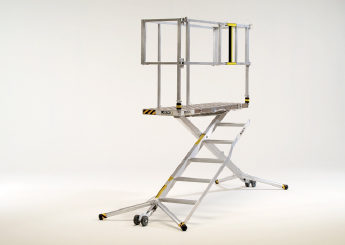The cost of scaffolding
What is the “true cost” of low-level scaffolding?

Responding is Chris Seaman, vice president, SafeTec, Bardstown, KY.
When you are looking into the costs involved with low-level scaffolding, you’ll find they are not as straightforward as you might imagine. Aside from the initial purchase of the scaffolding, there are indirect costs involved that a smart manager must consider before purchasing. These indirect costs include liability, OSHA, amount of usage, and who will be assembling and disassembling the scaffolding.
Direct costs:
- Steel scaffolding: OSHA-compliant steel scaffolding must include handrails. These low-level scaffolds can cost between $300-$800 depending on options and accessories.
- Aluminum scaffolding: OSHA-compliant aluminum scaffolding must include handrails. These low-level scaffolds can cost between $500-$1,000 depending on options and accessories.
- Accessories: Wheel kits (must be lockable): $35-$55 and planks (must have handrails): $300-$800
Indirect costs:
- Liability: Safety is No. 1 – your business must put safety first or your firm will be liable for any and all accidents. One scaffold injury could result in your company being responsible for $10,000-$100,000-plus in damages. Your business also loses the injured employee and you will need to hire someone new, which is both costly and time-consuming.
- Training: According to OSHA, the scaffolding must be assembled by a competent person and then tagged and inspected before use. If you have new equipment, new hires or have never had a training class, you are required to provide training for the low-level scaffolding. The costs involved include the hourly rate for the educator and the employees. A class might only be a couple of hours and might be provided free of charge by certain manufacturers, but you will always have the cost of the employees’ time. If you have a group of 10 people who spend an hour learning the proper use of scaffolding at an hourly rate of $20 an hour, it would cost your business $200. If you have to hire someone to certify your team, your cost could be in the $500-$1,500 range.
- Assembly and inspection: The average low-level scaffold takes two men to assemble and on average two hours. After your scaffolding is assembled, it must be tagged and inspected by a third person to be OSHA-compliant. All scaffolds must be logged and periodically inspected because pieces of scaffold have a habit of walking away. At most businesses, the time between assembly and inspection can be hours, if not the next day. This means that even after your team has assembled the scaffolding, it is not ready for use until the paperwork is done. If you have your two employees with an hourly rate of $20 an hour, it costs your business $40 every time you assemble the scaffolding. You must also consider the lost time between assembly and usage and the hourly cost of your third person doing the inspection. This means that assembly and inspection can cost your business between $100-$200 every time you assemble the scaffolding for usage.
- Disassembly: Disassembly costs time. It is important to stay organized in this process, or pieces of your scaffold might get lost. Disassembly takes less time than assembly, although you still have the cost involved for your employees’ time. Estimated costs is $20-$100.
- Transportation: Scaffolding comes in many pieces and can be cumbersome and sometimes difficult to transport, organize and store.
If your business is responsible and safety-conscious, the indirect costs end up costing more than the initial cost of the low-level scaffolding. Combining the lowest direct and smallest indirect costs, your least expensive basic steel scaffold can cost your company $6,540 if used weekly. “Cheap” scaffolding is never really cheap.
Editor's note: This article represents the independent views of the author and should not be construed as a National Safety Council endorsement.
Post a comment to this article
Safety+Health welcomes comments that promote respectful dialogue. Please stay on topic. Comments that contain personal attacks, profanity or abusive language – or those aggressively promoting products or services – will be removed. We reserve the right to determine which comments violate our comment policy. (Anonymous comments are welcome; merely skip the “name” field in the comment box. An email address is required but will not be included with your comment.)

